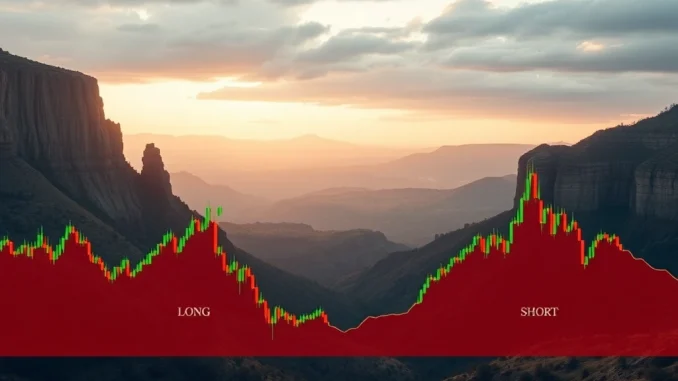
Hey crypto traders and enthusiasts! Ever wonder what the collective mood of the market is? Tracking data like the BTC perpetual futures long-short ratio gives us a window into trader sentiment. It’s a key piece of the puzzle when analyzing BTC trading data.
What is the Bitcoin Long Short Ratio?
Before we dive into the numbers, let’s quickly touch on what the Bitcoin long short ratio actually represents. In the world of futures trading, ‘long’ positions bet on the price going up, while ‘short’ positions bet on the price going down. The long-short ratio is simply the number of open long positions divided by the number of open short positions (or sometimes, the volume). A ratio above 1 indicates more traders are bullish (long), while a ratio below 1 suggests more traders are bearish (short). This metric is a snapshot of trader positioning and can offer insights into prevailing crypto market sentiment.
Analyzing the Latest BTC Trading Data
Let’s look at the recent BTC trading data for perpetual futures across major exchanges over the past 24 hours. This data provides a valuable glimpse into how traders are positioned in the short term.
Here are the key figures:
- Total Market: Long 50.4%, Short 49.6%
This overall figure indicates a very slight bias towards long positions across the market aggregate. It’s close to 50/50, suggesting a relatively balanced, perhaps indecisive, market sentiment on the whole.
Exchange-Specific Crypto Futures Analysis
Diving deeper, we can perform a more granular crypto futures analysis by looking at individual exchanges. Different platforms often show variations, which can sometimes point to specific trader demographics or strategies dominant on those sites.
| Exchange | Long % | Short % | Sentiment |
|---|---|---|---|
| Binance | 51.33% | 48.67% | Slightly Long |
| Bybit | 48.34% | 51.66% | Slightly Short |
| Gate.io | 51.85% | 48.15% | Slightly Long |
As you can see, Binance and Gate.io show a modest lean towards long positions, slightly higher than the market average. Interestingly, Bybit presents a slight tilt towards short positions. This variation highlights why it’s useful to look beyond just the total market number when conducting crypto futures analysis.
What Does This Crypto Market Sentiment Tell Us?
The overall crypto market sentiment, based on this 24-hour Bitcoin long short ratio data, appears nearly neutral with a fractional lean towards the long side. No single exchange shows an extreme skew in either direction. This lack of a strong directional bias could suggest a period of consolidation or uncertainty among traders regarding the immediate price movement of Bitcoin.
Interpreting these ratios is crucial for traders. While a heavily skewed ratio (e.g., 70% long or 70% short) might suggest potential for a counter-movement (as crowded trades can unwind sharply), the current balanced state indicates no overwhelming consensus. Traders are split almost down the middle on whether BTC will rise or fall in the very short term.
Putting BTC Perpetual Futures Data to Work
How can you use this BTC perpetual futures data? Think of it as one indicator in your trading toolkit. It doesn’t predict the future, but it helps gauge the current positioning of leverage traders. Combine this data with other forms of analysis, such as technical indicators, price action, and fundamental news, to build a more complete picture. Remember, ratios can change rapidly, especially in volatile markets.
Summary: A Balanced Market Mood
In conclusion, the latest 24-hour data on BTC perpetual futures long-short ratios reveals a market that is almost perfectly balanced between bullish and bearish bets. While Binance and Gate.io traders show a slight preference for longs, Bybit traders lean slightly short. This near-neutral crypto market sentiment suggests caution and a lack of strong conviction among leverage traders in the immediate term. Keeping an eye on this and other key metrics is vital for navigating the dynamic world of crypto trading.



